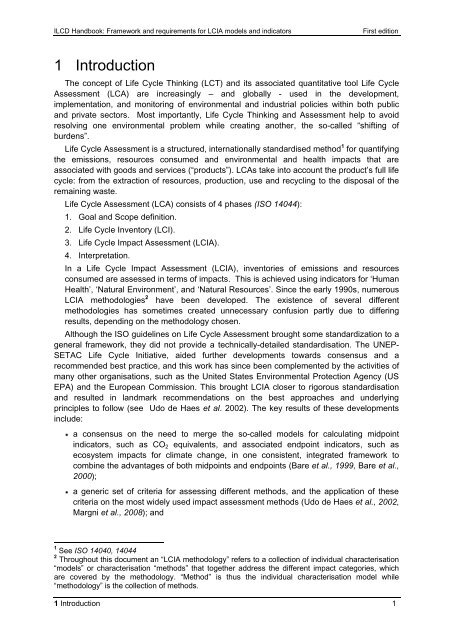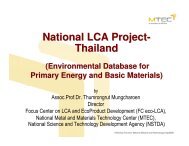ILCD Handbook: Framework and requirements for LCIA models and ...
ILCD Handbook: Framework and requirements for LCIA models and ...
ILCD Handbook: Framework and requirements for LCIA models and ...
You also want an ePaper? Increase the reach of your titles
YUMPU automatically turns print PDFs into web optimized ePapers that Google loves.
<strong>ILCD</strong> <strong>H<strong>and</strong>book</strong>: <strong>Framework</strong> <strong>and</strong> <strong>requirements</strong> <strong>for</strong> <strong>LCIA</strong> <strong>models</strong> <strong>and</strong> indicators First edition<br />
1 Introduction<br />
The concept of Life Cycle Thinking (LCT) <strong>and</strong> its associated quantitative tool Life Cycle<br />
Assessment (LCA) are increasingly – <strong>and</strong> globally - used in the development,<br />
implementation, <strong>and</strong> monitoring of environmental <strong>and</strong> industrial policies within both public<br />
<strong>and</strong> private sectors. Most importantly, Life Cycle Thinking <strong>and</strong> Assessment help to avoid<br />
resolving one environmental problem while creating another, the so-called ―shifting of<br />
burdens‖.<br />
Life Cycle Assessment is a structured, internationally st<strong>and</strong>ardised method 1 <strong>for</strong> quantifying<br />
the emissions, resources consumed <strong>and</strong> environmental <strong>and</strong> health impacts that are<br />
associated with goods <strong>and</strong> services (―products‖). LCAs take into account the product‘s full life<br />
cycle: from the extraction of resources, production, use <strong>and</strong> recycling to the disposal of the<br />
remaining waste.<br />
Life Cycle Assessment (LCA) consists of 4 phases (ISO 14044):<br />
1. Goal <strong>and</strong> Scope definition.<br />
2. Life Cycle Inventory (LCI).<br />
3. Life Cycle Impact Assessment (<strong>LCIA</strong>).<br />
4. Interpretation.<br />
In a Life Cycle Impact Assessment (<strong>LCIA</strong>), inventories of emissions <strong>and</strong> resources<br />
consumed are assessed in terms of impacts. This is achieved using indicators <strong>for</strong> ‗Human<br />
Health‘, ‗Natural Environment‘, <strong>and</strong> ‗Natural Resources‘. Since the early 1990s, numerous<br />
<strong>LCIA</strong> methodologies 2 have been developed. The existence of several different<br />
methodologies has sometimes created unnecessary confusion partly due to differing<br />
results, depending on the methodology chosen.<br />
Although the ISO guidelines on Life Cycle Assessment brought some st<strong>and</strong>ardization to a<br />
general framework, they did not provide a technically-detailed st<strong>and</strong>ardisation. The UNEP-<br />
SETAC Life Cycle Initiative, aided further developments towards consensus <strong>and</strong> a<br />
recommended best practice, <strong>and</strong> this work has since been complemented by the activities of<br />
many other organisations, such as the United States Environmental Protection Agency (US<br />
EPA) <strong>and</strong> the European Commission. This brought <strong>LCIA</strong> closer to rigorous st<strong>and</strong>ardisation<br />
<strong>and</strong> resulted in l<strong>and</strong>mark recommendations on the best approaches <strong>and</strong> underlying<br />
principles to follow (see Udo de Haes et al. 2002). The key results of these developments<br />
include:<br />
a consensus on the need to merge the so-called <strong>models</strong> <strong>for</strong> calculating midpoint<br />
indicators, such as CO2 equivalents, <strong>and</strong> associated endpoint indicators, such as<br />
ecosystem impacts <strong>for</strong> climate change, in one consistent, integrated framework to<br />
combine the advantages of both midpoints <strong>and</strong> endpoints (Bare et al., 1999, Bare et al.,<br />
2000);<br />
a generic set of criteria <strong>for</strong> assessing different methods, <strong>and</strong> the application of these<br />
criteria on the most widely used impact assessment methods (Udo de Haes et al., 2002,<br />
Margni et al., 2008); <strong>and</strong><br />
1 See ISO 14040, 14044<br />
2 Throughout this document an ―<strong>LCIA</strong> methodology‖ refers to a collection of individual characterisation<br />
―<strong>models</strong>‖ or characterisation ―methods‖ that together address the different impact categories, which<br />
are covered by the methodology. ―Method‖ is thus the individual characterisation model while<br />
―methodology‖ is the collection of methods.<br />
1 Introduction 1



